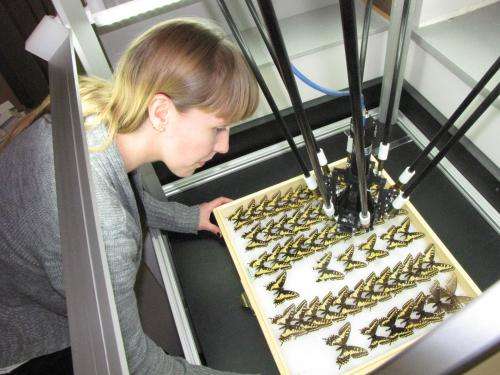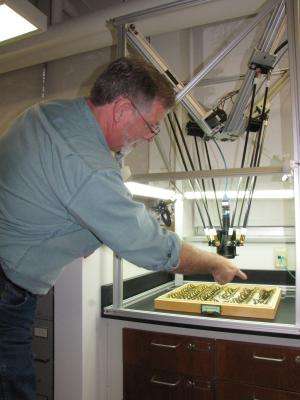Scanning robot helps put insect collection online

A robot capable of scanning a tray of insect specimens in a few minutes will help make the virtual images and tagging information available to the public online, according to South Dakota State University entomologist Paul Johnson, director of the Severin-McDaniel Insect Research Collection. Information is being posted on the project website, invertnet.org, as well as national and international websites.
When climate changes, insects have the ability to adapt more quickly than vertebrates, Johnson explained.
"Insects can be used as measuring devices for landscape changes on a local and regional scale."
The work is part of a 10-year, $100 million National Science Foundation grant to capture images and specimen data from millions of natural history specimens at institutions throughout the country and to provide greater information access to researchers and other stakeholders. The InvertNet Project, led by the University of Illinois in Champaign, involves 21 other universities and two natural history museums, one in Milwaukee and the other in Pittsburgh, together containing more than 60 million specimens.
The project seeks to create a database of the specimens in natural history collections, automatically transcribe the data on the specimen labels and take digital images of each specimen, Johnson explained. "By using advanced imaging technologies, we will have 3-D explorable files for analysis."
That combined information is then uploaded into national and international databases so people can use it to analyze geographic and ecological patterns.
Until now, data have been collected and entered manually, Johnson explained. Eight SDSU graduate and undergraduate students have worked on this project during the last three years.

This fall, each collaborating institution is testing a prototype robot that can scan more than 100,000 specimens in a week, gathering information that would take three to four years to compile manually, Johnson explained. "This robot can increase the efficiency and decrease the cost of gathering this data."
Johnson and Rita Velez, collection manager, will do beta testing of the scanning robot figuring out how to best use the robot to image their specimens and identifying any glitches in the equipment or software as they add collection information to the database.
"This will be a major contribution to gathering biodiversity data and being able to analyze what's happening," Johnson said. "Scientists will be able to identify and recognize species more effectively, know where they are and discover new species in the ever important exploration of biodiversity."
"The larger project is as cutting edge as anything in the natural sciences and is a great boon to South Dakota science capacity," Johnson added. This technology will improve collaborations within the global taxonomy and museum communities and help scientists demonstrate the value of these collections.
Provided by South Dakota State University

















